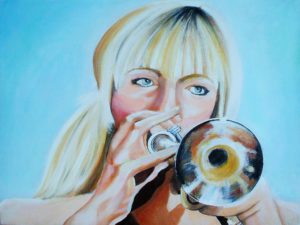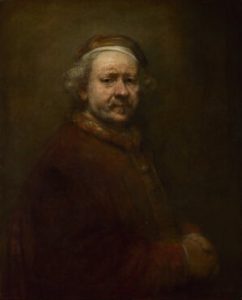It’s that time of year again, the art portraiture silly season! The Royal Society of Portrait Painters exhibition coming to the Mall Galleries, The BP National Portrait Awards judged ready for the annual show at the National Portrait Gallery, The Sky Arts “Portrait Artist of the Year”, another TV series “The Art of the Portrait”, The BBC’s Big Painting Challenge (at least in part) and a host of other smaller scale competitions and exhibitions are all taking place in the first half of 2017. The trouble is, and I’ve said this before, many entrants are judged initially on images reproduced digitally, which in my view is flawed. You can’t really assess a work of art unless you see and experience the original at first hand by physically confronting the work, its size, the medium, its colours, shape, form, techniques, texture and all the other elements that comprise the complete creation. So many times I’ve looked at an artwork online, dismissed it, seen it later at first hand, and loved it! However, the high profile events generate so much interest amongst amateur and professional artists, with thousands of entries, that there seems to be no other practical method of selection to arrive at manageable shortlists of finalists.
As portraits are currently so popular, I thought I’d look more closely at the subject. I like to paint people who I admire and who interest me, whether alive or dead; many are composers, songwriters, musicians and actors. Unfortunately for me, I have no direct access to the living ones as most are famous so they’re not aware of me and can’t sit as my model. Many argue that unless you know the person you paint, draw or sculpt, you can’t convey an accurate likeness or portray their personality and make a true portrait – neither is it possible to enter into their mind through conversation or bring them to life on canvas by having a personal and intimate relationship with them. The most recent portrait of mine is of Alison Balsom, the attractive and brilliantly consistent trumpet soloist who I’ve been struggling to paint in action from a collection of photos. Here is one of the problems associated with judging and assessing copies reproduced from the original painting (which is not yet finished).

Alison Balsom
I know a little about Alison Balsom’s life through her publicity, her website and the media and have seen and heard her playing live in concert. I have also bought some of her recordings. She seems, from filmed interviews, to be charming, articulate, kind, caring and eager to educate and promote music (brass in particular) with young people, no matter what their background. I also know what it’s like to play brass instruments such as the trumpet and trombone, as I was a performer. I appreciate how much practice is needed, the stress of playing in public and the technical problems that exist with the instruments. However, none of this helps when trying to commit Alison to canvas or paper. I have to forget the music and refer to pictures that are publicly available which are also unsatisfactory as each is different – the pose, expression, hairstyle, colouring, context and so on. I also have to beware of infringing copyright in the photos!
Distinguished portrait artists say that love, mortality, humanity, visual conversations, control by the artist are key requirements for successful results. When using photos, this is virtually impossible, which is the case here where the subject is performing and concentrating on her playing from memory or from printed music. Is the artist in the way? Is the subject dominating the artist? With me the latter is always the case, simply because it is always a struggle or even a battle to achieve a good likeness! Looking at the image of the person being painted is always more important and the time spent on observation has to be much longer than the painting process! I’ve listened to several eminent portraitists such as Maggie Hambling, Jason Brooks, Jonathan Yeo, Humphrey Ocean and Michael Landy talk about their sitters and seeking out a truthful version of the person being painted. All seem agreed that it is not easy and stress the that the key is looking at the subject rather than down at what happens on the canvas.
Perhaps the most successful of all portraitists from the past, was Rembrandt “the most human of painters” according to Maggie Hambling. His fluidity and skill with the paintbrush, fingers and thumbs, the ability to mould flesh with arrays of sticky colour in magical “sexy” oil paint is beyond words, conveying mortality at its finest. The marks made by Rembrandt have energy and vitality which few have successfully or convincingly imitated since. This self-portrait astounds and transfixes me every time I see it; unfortunately what you see here is an image which conveys very little of the sculpted perfection of the original viewed at first hand!

Every time I look at his portraits and self-portraits in the National Gallery in London, I come away totally overwhelmed by the experience, yet still determined to follow my own dreams to try and produce a half decent attempt at painting my chosen subjects in a style which suits me at the time, even though few are ever done from life.


